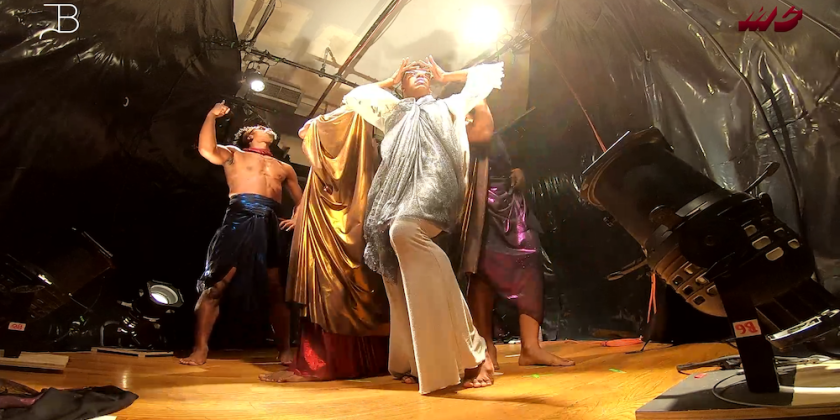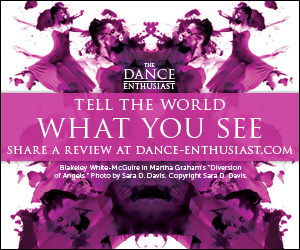IMPRESSIONS: j. bouey's "SATURN, A Revelation" at JACK, Brooklyn

Introducing the Inter-Dimensional Time-Traveling Disco Space Opera Dance Band, The Living Ancestors
SATURN, A Revelation presented by JACK
The Inter-Dimensional Time-Traveling Disco Space Opera Dance Band
Conceived by j. bouey
Designed by George Del Barrio
Oracle Libretto read live by Junauda Petrus
Playlist mixed live by Tyrone Bevans
Performed by j. bouey, Jayson P. Smith, Quilan “Cue” Arnold, Tyrone Bevans
May 10 – 25, 2024
*Cover image: j. bouey, Jayson P. Smith, Quilan “Cue” Arnold, Tyrone Bevans perform from inside the light stage
SATURN, A Revelation, Introducing the Inter-Dimensional Time-Traveling Disco Space Opera Dance Band, The Living Ancestors, a performative expression of positive-thinking activism conceived by j. bouey, takes place at JACK, an arts and community space in Brooklyn committed to social causes. The work, billed as an immersive experience, relies on a sci-fi storyline, a declarative playlist, the use of Camera Obscura technology and a cast of great movers known as The Living Ancestors. This performance vivifies j. bouey’s social activist construct.
Dance artist and astrologer, j. bouey with Junauda Petrus builds a liberation backstory for SATURN, A Revelation, Introducing the Inter-Dimensional Time-Traveling Disco Space Opera Dance Band, The Living Ancestors, based on j. bouey’s childhood fascination with the heroism of X-Men comics. The Living Ancestors, as the story goes, run through the Underground, a society of the non-enlightened who evade GAHD. The Ancestors “travel through time and dimensions and dream of utopia,” where humanity lives in harmony with the Earth and each other. The four performers, j. bouey, Jayson P. Smith, Quilan “Cue” Arnold, Tyrone Bevans, embody the Ancestors who lead this artist revolution. Says j. bouey, “To our future descendants, we are the living ancestors.”

Transformed into a pitch-black cave, the center of the JACK space is enclosed in floor to ceiling black plastic from which the performers’ twilit real-time dancing is "surface-mapped" projected at magnified scales simultaneously by Camera Obscura operators. Camera Obscura, (Latin: “dark – obscura” and “room - camera”), used by artists and scientists for centuries, and the precursor of the modern camera, requires a container (a room or box) through which a hole or lens projects an inverted reversed image, offering a unique perspective, onto the opposite wall. In this case, projected onto screens that are life-sized at varying heights situated on the space’s four interior white walls, as well as on the walls themselves.

The audience walks from projection to projection, following the active images. Sometimes the performers’ diffracted golden images are projected as trails of light; other times the images are clear and distinct. There is not much variation in the dance movement, as the performers, dancing from the waist up, are limited to moving their arms and torso and rely on a narrow band of improvised Waacking and Punking. j. bouey offers a slight diffentiation by swirling light maroon fabric as if flying. The floor occasionally shakes with the animated dancing of The Living Ancestors, letting us know that there are real live dancers among us and not just projections. The performers also softly exhort one another.

Juanuda Petrus's poem, Can We Please Give The Police Departments To The Grandmothers? is read live as part of Petrus's Libretto, ("Grandma knows what oppression has done to our souls and is gonna change it one love temple at a time.") A playlist of music by Tyrone Bevans tells a feel-good story. It includes classic 1970-1990s disco and gospel, and features the harmonies of the great Minnie Riperton spreading love and joy, and Prince vocalizing in his singular style about Love And Sex. The playlist opens with Vertigo singing Relight My Fire (“if we all stand up in the name of love”) to the final selection, Saturn by Stevie Wonder who speaks of utopian community (“I’m going back to Saturn where the rings all glow, Rainbow moonbeams and orange snow”) that concludes with the happy play sounds of children suggesting a hopeful future.

The j. bouey Dance Projects website lists numerous articles, a podcast and classes that address systemic oppression in the dance community. For instance, overcoming harassment and abuse of dancers, disabled artists’ accessibility and inclusivity, and dismantling white supremacy in dance institutions. j. bouey, an outward acting artist, points out inequities, but patiently, and often exuberantly, encourages the community to gather and change for the greater good.












